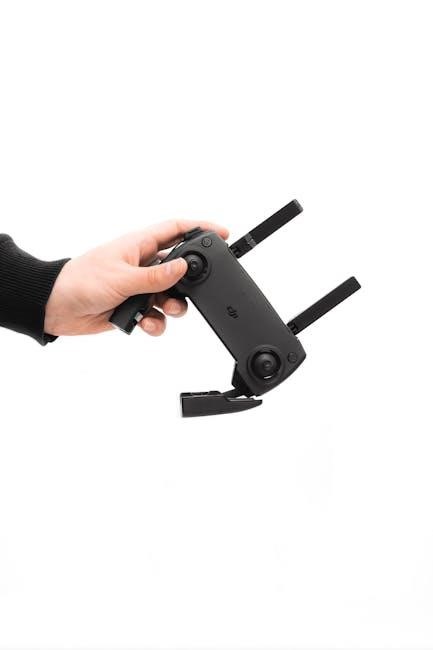Welcome to the Inkbird Controller Manual! This guide provides a comprehensive overview of Inkbird temperature controllers, covering installation, operation, and troubleshooting. Designed for both beginners and experienced users, it ensures safe and effective use of Inkbird devices.
1.1 What is the Inkbird Controller?
The Inkbird Controller is a versatile and reliable temperature control device designed for precise temperature management in various applications. It is a plug-and-play solution that offers dual relay output, allowing users to control both heating and cooling systems efficiently. The controller features an LCD display for real-time temperature monitoring and is compatible with a wide range of electric appliances, such as homebrew equipment, aquariums, and BBQ setups. Its user-friendly interface and robust design make it suitable for both beginners and experienced users. The Inkbird Controller is widely recognized for its accuracy, durability, and ease of use, making it a popular choice for temperature control needs in home, commercial, and industrial settings. Whether for maintaining optimal temperatures in fermentation processes or ensuring consistent heat in reptile enclosures, the Inkbird Controller delivers reliable performance and flexibility.
1.2 Applications of the Inkbird Controller
The Inkbird Controller is a highly versatile device with a wide range of applications, making it a valuable tool for various industries and hobbies. It is commonly used in homebrewing to maintain precise fermentation temperatures, ensuring consistent and high-quality brews. Aquarium enthusiasts rely on it to regulate water temperature, creating a stable environment for aquatic life. Additionally, it is widely used in pet breeding and incubation processes to provide optimal thermal conditions for healthy development.

The controller is also popular among BBQ enthusiasts for maintaining consistent smoking temperatures, ensuring perfectly cooked meats. Furthermore, it is used in seedling heat mats, oven temperature control, and terrestrial heat control systems. Its dual relay output and precise temperature management make it ideal for both heating and cooling applications. Whether for professional or personal use, the Inkbird Controller is a reliable solution for achieving accurate temperature control in various settings.

1.3 Importance of the Manual
The Inkbird Controller Manual is an essential resource for anyone looking to maximize the potential of their device. It provides detailed instructions for installation, operation, and troubleshooting, ensuring users can safely and effectively utilize the controller. Whether you’re a beginner or an experienced user, the manual offers clear guidance to help you understand the device’s advanced features and configurations.
The manual is particularly important for troubleshooting common issues and optimizing the controller’s performance. It includes step-by-step instructions for temperature calibration, alarm settings, and switching modes, which are critical for precise temperature control. Additionally, the manual highlights safety precautions and best practices to prevent damage to the device or connected equipment.

By following the manual, users can unlock the full capabilities of the Inkbird Controller, ensuring accurate and reliable temperature management. It serves as a valuable reference for both initial setup and ongoing use, helping users achieve their goals efficiently and effectively. Regularly consulting the manual ensures optimal performance and extends the lifespan of the device.
Key Features of the Inkbird Controller
The Inkbird Controller boasts dual relay output for precise temperature control, an LCD display for clear readings, and a wide temperature range. Its plug-and-play design ensures easy installation and operation, making it versatile for various applications.
2.1 Overview of Features
The Inkbird Controller is a versatile and user-friendly device designed for precise temperature control. It features dual relay output, allowing for both heating and cooling operations, and is equipped with an LCD display for clear temperature readings. The controller supports a wide temperature range, making it suitable for various applications such as homebrewing, aquariums, and BBQ. Its plug-and-play design ensures easy installation, while the intuitive interface enables seamless navigation and configuration. The device also offers advanced features like temperature calibration and alarm settings, enhancing its functionality for both beginners and experienced users. With its robust construction and reliable performance, the Inkbird Controller is an ideal choice for maintaining consistent temperatures in different environments. Whether for industrial or domestic use, this controller provides accurate and efficient temperature management, ensuring optimal results in every application.
2.2 Dual Relay Output
The Inkbird Controller features a dual relay output, enabling it to manage both heating and cooling systems efficiently. This functionality allows the controller to automatically switch between modes based on the set temperature parameters, ensuring precise control over your environment. The dual relay design enhances flexibility, making it suitable for a wide range of applications, from homebrewing and aquariums to incubation and BBQ setups. With this feature, you can connect two separate devices—one for heating and one for cooling—allowing the controller to activate the appropriate system as needed. This ensures consistent temperature maintenance, which is crucial for processes like fermentation or pet breeding. The dual relay output also provides over-temperature protection, safeguarding your equipment and ensuring safe operation. By supporting both heating and cooling, the Inkbird Controller offers a comprehensive solution for temperature control, making it a versatile tool for various industries and hobbies.

2.3 LCD Display
The Inkbird Controller is equipped with a clear and intuitive LCD display, providing real-time temperature readings and system status. This feature allows users to easily monitor the current temperature, setpoint, and operating mode. The display is designed for readability, ensuring that critical information is always visible, even in low-light conditions. With the LCD screen, you can quickly navigate through settings and confirm changes without confusion. The display also shows alarm notifications and mode indicators, keeping you informed about the controller’s operational state. This user-friendly interface simplifies the process of adjusting settings and understanding the controller’s functions. The LCD display is a key component that enhances the overall usability of the Inkbird Controller, making it accessible for both novice and experienced users. Its clarity and responsiveness ensure that you can rely on it for precise temperature monitoring and control in various applications.
2.4 Temperature Range
The Inkbird Controller offers an impressive temperature range, making it suitable for a wide variety of applications. The ITC-308 model, for instance, supports a temperature range of -50°C to 120°C (-58°F to 248°F), ensuring precise control in both low and high-temperature environments. This broad range allows the controller to be used in applications such as homebrewing, aquariums, incubation, and even industrial processes. The controller’s ability to handle such a wide temperature spectrum makes it highly versatile and adaptable to different user needs.
The temperature range is also complemented by high accuracy, typically ±1°C, ensuring reliable and consistent performance. This level of precision is crucial for maintaining optimal conditions in sensitive environments, such as fermentation or reptile habitats. Whether you’re monitoring freezing temperatures or high heat, the Inkbird Controller delivers accurate and stable control, making it a trusted tool for both hobbyists and professionals. Its robust temperature range and precision ensure that it can meet the demands of various scenarios, providing users with confidence in its performance.

Installation Guide
The Inkbird Controller installation process is straightforward, requiring basic tools and adherence to safety standards. Ensure proper wiring connections and power supply. Refer to the manual for detailed step-by-step instructions to ensure safe and effective setup.
3.1 Hardware Requirements
To install and operate the Inkbird Controller effectively, ensure you have the necessary hardware components. The controller unit itself is the core component, requiring a stable power supply (typically 12V or 24V DC, depending on the model). A temperature probe or sensor is essential for accurate readings, and it should be compatible with the controller’s input specifications.
- A suitable power adapter or wiring for the controller.
- A temperature probe (usually included with the controller).
- Relay modules or output devices (if not already integrated).
- Mounting hardware (e.g., screws or brackets) for secure installation.
Ensure all connections are secure and meet safety standards to avoid damage or malfunction. Refer to the manual for specific voltage and compatibility requirements to ensure optimal performance and safety.
3.2 Step-by-Step Installation

Installing the Inkbird Controller is a straightforward process that requires careful attention to detail. Begin by unboxing the controller and ensuring all components, including the temperature probe and wiring, are included. Mount the controller in a convenient location using the provided screws or brackets, ensuring it is easily accessible for operation.
- Connect the temperature probe to the designated input port on the controller. Ensure it is securely attached to the device or area you wish to monitor.
- Wire the power supply to the controller, following the polarity markings to avoid damage. Connect the positive (VCC) and negative (GND) wires to the appropriate terminals.
- Attach the output wires to the relay or heating/cooling device. Double-check the wiring diagram in the manual to ensure correct connections.
- Power on the controller and verify that the LCD display lights up and shows the current temperature reading. If not, check all connections for accuracy.
- Once powered on, navigate through the interface to set your desired temperature parameters and operating mode.

By following these steps, you can ensure a safe and proper installation of your Inkbird Controller, ready for precise temperature control.
3.3 Wiring Guidelines
Proper wiring is essential for the safe and effective operation of your Inkbird Controller. Begin by connecting the temperature probe to the designated input port, ensuring it is securely attached to the device or area you wish to monitor. Next, connect the power supply to the controller, paying close attention to the polarity markings to avoid damage. Use the correct wire gauge and ensure all connections are tight and free from short circuits.
- Connect the positive (VCC) and negative (GND) wires to the appropriate terminals on the controller.
- Attach the output wires to the relay or heating/cooling device, following the wiring diagram provided in the manual.
- Double-check all connections to ensure they are secure and correctly routed.
- Avoid overloading the controller by connecting devices that exceed its rated capacity.
For added safety, use a multimeter to verify the integrity of your connections before powering on the controller. Always refer to the wiring diagram in the manual for specific instructions tailored to your model. Proper wiring ensures reliable performance and prevents potential damage to your Inkbird Controller or connected devices.

Operating Instructions
Learn to operate your Inkbird Controller effectively. Turn it on/off with a simple key press, navigate through settings using intuitive buttons, and monitor real-time temperature readings on the LCD display for precise control of your system.
4.1 Turning the Controller On/Off
To turn the Inkbird Controller on, press and hold the power key for more than 1 second while in the off state. The device will power up and display the current temperature reading. To turn it off, press and hold the same key for more than 3 seconds while in normal working mode. The controller will shut down, and the display will go dark. Ensure the device is properly powered and connected to avoid any issues during startup or shutdown. Always refer to the manual for specific button locations and timing to prevent accidental malfunctions. Proper on/off operations are essential for maintaining the controller’s longevity and ensuring accurate temperature control. By following these steps, you can efficiently manage the controller’s power status for your specific application, whether it’s for brewing, incubation, or other temperature-sensitive tasks.
4.2 Navigating the Interface
Navigating the Inkbird Controller’s interface is straightforward and intuitive. The controller features a user-friendly LCD display that shows current temperature readings, mode status, and menu options. Use the navigation buttons to scroll through settings and options. The up and down arrows allow you to adjust values, while the enter key confirms selections. Press and hold the power key to toggle between heating and cooling modes or to access advanced features. The interface automatically switches between modes based on the set temperature, ensuring seamless operation. For detailed menu navigation, refer to the manual to understand each icon and symbol. Proper navigation ensures precise control over your temperature settings, making it easy to customize the controller for your specific needs, whether for brewing, incubation, or other applications. By familiarizing yourself with the interface, you can optimize the controller’s performance and achieve consistent results.
4.3 Understanding Display Readings
The Inkbird Controller’s LCD display provides clear and real-time information to monitor your temperature settings. The screen shows the current temperature, setpoint, and operating mode (heating or cooling). The display updates continuously, ensuring you have accurate readings at all times. When navigating through the menu, the display will show the selected option, making it easy to confirm your settings. The controller also indicates alarm statuses, such as temperature deviations or system errors, with specific symbols or messages. Understanding these readings is crucial for maintaining precise control over your environment. For example, the display will show “HE” for heating mode and “COOL” for cooling mode, allowing you to verify the active operation. Additionally, the screen may flash or display an alarm code if the temperature exceeds safe limits. Familiarizing yourself with these readings ensures optimal performance and helps you address any issues promptly. Always refer to the manual for a detailed explanation of all symbols and codes.
Advanced Features
The Inkbird Controller offers advanced features like temperature calibration, alarm settings, and switching modes for precise control. These features enhance functionality, ensuring accurate and reliable performance in various applications with an intuitive interface for easy monitoring.

5.1 Temperature Calibration
Temperature calibration is a crucial feature of the Inkbird Controller, ensuring accurate temperature readings and control. Calibration allows users to adjust the controller to match their specific needs, enhancing precision in applications like brewing, incubation, or reptile care. To calibrate, access the menu by pressing and holding the appropriate keys, then adjust the temperature offset to align with a reference thermometer. This feature is especially useful for maintaining consistent conditions in sensitive environments. Regular calibration ensures optimal performance and reliability, preventing deviations that could affect your setup. The process is straightforward and detailed in the manual, making it accessible for all users. By calibrating your Inkbird Controller, you can trust the readings and rely on precise temperature management for your projects. This feature underscores the controller’s versatility and commitment to user satisfaction, ensuring it meets the demands of various applications with ease and accuracy.
5.2 Alarm Settings
The Inkbird Controller features advanced alarm settings to notify users of temperature deviations, ensuring optimal conditions for various applications. These alarms can be programmed to trigger when temperatures exceed set limits, providing over-temperature protection and preventing potential damage to equipment or environments. Users can configure high and low-temperature alarms, with customizable thresholds to suit specific needs, such as homebrewing, aquariums, or reptile care. The controller offers both visual and audible notifications, ensuring immediate attention when conditions fall out of range. This feature is particularly useful for maintaining consistent temperatures in sensitive environments, such as incubation or seedling growth. By enabling alarms, users can monitor their systems remotely and take corrective action promptly. The alarm settings enhance the controller’s functionality, offering peace of mind and reliable performance across diverse applications. This feature is a testament to the Inkbird Controller’s versatility and commitment to user convenience, ensuring precise temperature management and system safety.
5.3 Switching Modes
The Inkbird Controller offers seamless switching between heating and cooling modes, adapting to your specific needs. In normal operation, the controller automatically switches modes based on the set temperature, ensuring precise control. For manual override, users can press and hold the designated key to change modes, providing flexibility in various applications such as brewing, reptile care, or greenhouse management. This feature is particularly useful for maintaining consistent temperatures in environments requiring both heating and cooling, such as incubation or fermentation processes. The controller’s interface displays the current mode, allowing users to monitor and adjust settings effortlessly. Whether you’re managing a homebrew setup or controlling temperatures for pet care, the Inkbird Controller’s mode-switching capability ensures optimal performance. This feature, combined with its dual relay output, makes it a versatile tool for diverse applications. By enabling smooth transitions between modes, the Inkbird Controller enhances user convenience and system efficiency, catering to both basic and advanced temperature control needs.
